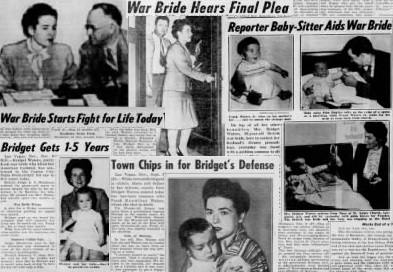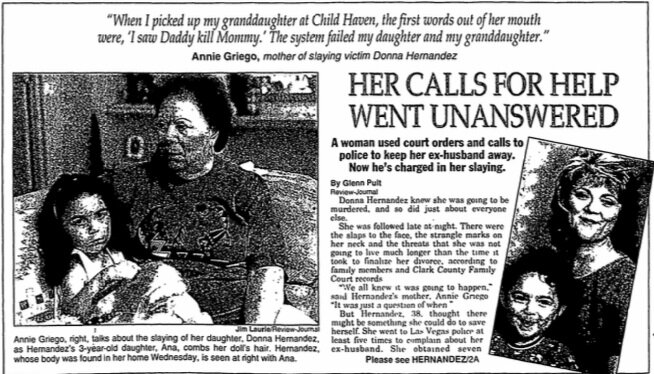domestic disturbances
“She doesn’t have long to live.”
Domestic violence often can have deadly results. Below is a partial list of the carnage wrought by domestic disturbances in Sin City.
Contractor and pilot John Covarrubias crashed his plane into a bar along Boulder Highway after his ex-wife refused to reconcile. The unprecedented suicidal attack drew the attention of Las Vegas media, though this attempted mass murder is largely forgotten today. (Las Vegas-Clark Country Library District)
crash and burn
Things came to a head for 38-year-old Las Vegas building contractor and amateur pilot John Covarubbias on Friday night, April 9, 1965. John had divorced from his wife of 17 years, Nellie Covarubbias, the year before. On top of that, John was having financial difficulties with his contracting business while Nellie was succeeding with the small bar she owned along Boulder Highway, the stretch of roadway between Las Vegas and the town of Henderson.
John showed up at Nellie’s bar – the Branding Iron Bar – early that Friday night to see if she was open to reconciling. Nellie was not. Her ex-husband’s sweetness transformed to rage, and John told several patrons that Nellie would not be around for much longer before storming out.
After drowning his emotions in alcohol, John eventually made his way to McCarrain Airport where his Cessna 310 was parked. John started the plane, tore down the runway, and turned toward Boulder Highway. He located the Branding Iron Bar and aimed his plane squarely at the entrance. Perhaps because of his intoxication, John missed landing a direct hit on the bar, instead careening his plane into a row of cars parked in front of the establishment. The cars softened the impact as the plane exploded and set the north side of the bar alight.
Fate would prevent a larger tragedy. Most of the 30 bar patrons had just left the dance floor located on the north side of the bar that bore the brunt of the plane crash and had taken seats along the south side of the building. The only serious injury was suffered by a patron that sustained wounds from burning gasoline, though he ultimately recovered at nearby St. Rose de Lima Hospital. John perished instantly, his body located between a smoldering car and the wall of the Branding Iron Bar.
Sergeant Henry Prendes, murdered responding to a domestic dispute call. Officer Prendes is memorialized online and at the police officer’s monument in Las Vegas. (ODMP)
a deadly call
On the night of February 1, 2006, Las Vegas 911 dispatchers received a call from Geri Gonzado that her 21-year-old boyfriend Amir Crump - an aspiring rapper working under the name “Trajik” – was ransacking the house and punching her during a heated argument. Gonzado warned police that Crump was armed.
Among the first officers to arrive to the call were Sergeant Henry Prendes and Officer Michael Pagnotta. Sargeant Prendes noticed the front door of the two-story house was open and began heading toward the entrance. Officer Pagnotta urged his colleague to wait for additional backup since they had no idea where the suspect was located, but Prendes insisted on trying to make a quick arrest. Prendes announced he was with the police and proceeded through the open front door.
Crump had been waiting for officers to arrive. Positioned on a landing leading to the second floor, Crump fired several shots from an AK-47 replica assault rifle, striking Sergeant Prendes multiple times in the chest. The wounded officer staggered back out the front door and collapsed on his back, grasping his chest. Sergeant Prendes was still conscious and breathing, but when Officer Pagnotta attempted to drag his superior to safety, a staccato of gunfire erupted from a second-story window. Officer Pagnotta and recently arrived police dove for cover as rounds struck patrol cars and ricocheted off the street. Amidst the melee, Crump emerged from the house and fired a single round into Sergeant Prendes’s head, killing him instantly.
Officers armed with assault rifles eventually arrived on the scene and turned the tide. While pinned down with rifle fire, a team of officers were able to charge Crump and kill him with several shotgun rounds. A coroner’s inquest later found that Crump had taken excessive amounts of Ecstasy the night of the shootings. Meanwhile, the community gathered to mourn the death of Sergeant Prendes, the first Las Vegas law enforcement officer to be killed in the line of duty in 17 years.
The murder by Bridget Waters of her estranged husband during a custody exchange made international headlines. (California Digital Newspaper Collection, UCR)
deadly custody exchange
During World War II, thousands of British women married American servicemen while they were stationed overseas. Many of these relationships ended at the conclusion of the War when these servicemembers returned to the States, which often left their wives and children struggling for support. But Bridget Waters was one “war bride” undeterred by her husband’s return home.
Frank Waters, a lawyer and defense contractor from California, met Bridget while stationed with the U.S. Army in Britain. The two wed and had a child in short order. But once the war was over and Frank returned home, he decided he wanted to move on. For a while he sent child support checks to Bridget back in Britain, but soon those too stopped. The next contact Bridget received from her husband was news that he had moved to Las Vegas for a “quickie divorce.”
In 1946, Bridget Waters, sponsored by British aid societies seeking to establish legal precedents requiring American husbands to support their deserted wives and children, flew across the globe to the then tiny desert town of Las Vegas to contest Frank’s divorce suit. Frank sought divorce on the grounds of infidelity, but Bridget was able to prove her faithfulness at trial and even introduced evidence that Frank was the one that strayed from the marital bonds. The jury agreed with Bridget and denied Frank’s efforts to obtain a divorce, awarding the young Irish immigrant a small sum for child support and alimony. Frank settled into a job as a banker in Las Vegas as he attempted to establish alternate grounds for divorce.
On Labor Day of 1946, Frank arrived at the house where Bridget worked as a maid. Bridget’s employer was away on vacation, so the home was occupied only by her and the couple’s toddler son. An argument ensued that ended when Bridget exited the living room. When she returned, she had a .22 pistol in hand. She fired a single shot into her husband’s back while he crouched over their child – the bullet entered Frank’s heart and killed him instantly.
Bridget plead self-defense and temporary insanity, arguing that she feared Frank intended to harm their child. Her trial became an international sensation. The jury ultimately found Bridget guilty of the lowest possible charge – involuntary manslaughter. Bridget was released after serving 15 months in prison and was exiled from the United States. After making an uneventful return to Britain with her son, she ultimately moved to Canada where she worked for decades as a nurse.
The Bridget Waters case was not the last incident of a “war bride” murdering her American husband in Las Vegas. Local press offered a sympathetic view of Alice White, who murdered her abusive husband while he slept. (Las Vegas-Clark County Library District)
mother’s day slaying
Another “war bride” murder rocked Las Vegas during the early hours of Mother’s Day, 1953 when 32-year-old Alice White – a mother of two young children that was pregnant with her third child – fired a shotgun into the head of her husband, Sergeant Andrew White, while he slept at their apartment on the grounds of Nellis Air Force Base on the north-eastern edge of the city.
Alice was tried for murder, and much controversy around her case in the local press focused on the fact that Alice was a married woman when she met Andrew while he was stationed in England. At trial it came out that Alice’s husband was an excessive drinker and had beaten and threatened to kill her the night she shot him. Testifying in her own defense, the soft-spoken woman explained that she feared her husband had no intention of letting her live long enough to go to the Nellis Air Force Base legal officer to seek support for herself and their children. Alice also explained to the jury that she had been separated from her first husband for two years at the time she met Andrew White in 1944.
The jury was moved by Alice’s testimony that painted a vivid picture of the abusive hell Andrew subjected upon his family. Alice was acquitted of the murder charges. Upon her release, she immediately rejoined her children and told reporters that she could “for the first time think about the future.”
George Cooper shot his estranged wife and her boyfriend to death. Cooper was convicted of a lesser manslaughter charge for the slayings, a verdict the local press expressed outrage over. (Las Vegas-Clark County Library District)
.38 caliber divorce
George and Nancy Cooper were living separate though still married on the night of November 16, 1979. A little after midnight, George took the fifteen-minute drive from their home near downtown Vegas over to the townhouse where Nancy was staying. Upon arriving, George used a secret key to gain access to the residence where he encountered Nancy spending the night with another man, 29-year-old Scott Willis. After a brief argument several shots rang out, leaving Nancy and Scott dead in bed.
George returned home. At about 10:00 a.m. that morning he asked a friend to come with him to the townhouse to check on Nancy. George feigned shock at discovering the bodies of his wife and her lover and frantically called the police. Investigating officers immediately sensed something suspicious about George’s story and placed him under arrest.
At trial, George argued that he had murdered Nancy and Scott Willis in “a heat of passion” and as a result should only be found guilty of the lesser charge of manslaughter. The jury agreed and found for the lighter charge, though the presiding judge issued the maximum penalty of 20 years in prison for manslaughter. The District Attorney on the case was outraged by the verdict, arguing that the law should not condone “.38 caliber divorce.”
Articles at the time of court employee Donna Hernandez’s murder at the hands of her ex-husband focused on the fact Donna repeatedly sought court and police intervention to stop her husband’s threats before it was too late. Donna’s murder led to the creation of Donna’s House at Clark County Family Court in Las Vegas, a location to safely conduct custody exchanges. (Las Vegas-Clark County Library District)
a broken system
On October 6, 1999, Fernando Hernandez broke into the Las Vegas home of his ex-wife, Donna Hernandez, and proceeded to repeatedly stab and strangle his former spouse in front of their 3-year-old daughter. But this brutal and traumatizing crime was made all the worse because Donna knew it would happen, yet she could get no one in a position of power to help her before it was too late.
Donna and Fernando’s marriage soured fairly quickly after they took their vows. Despite Donna teaching Fernando how to speak English and buying him a sports car with the money she had saved over the years in her job as a clerk at the Clark County Family Court, her husband subjected her to a constant regimen of physical and mental abuse. Donna was tired of the beatings and of the fact the police did nothing when she reported the domestic violence, and so she eventually divorced Fernando and obtained custody of their daughter.
But a decree of divorce and protective orders did little to stop Fernando’s efforts to terrorize Donna. In the period after their divorce, Fernando threatened Donna with a screwdriver; vandalized her car; followed Donna in his vehicle; broke into her home; and smashed his truck into her garage. The last incident resulted in Fernando being convicted of a misdemeanor disorderly conduct charge, but for the most part police just told Fernando to “stay away” from his ex-wife. Police often failed to even log when Fernando violated protective orders issued by judges at the Family Court where Donna worked. The worst part for Donna was the requirement to have regular face-to-face contact with Fernando for the court-ordered custody exchanges.
The murder of Donna Hernandez resulted in public outrage over the ineffectiveness of the legal system and police to prevent domestic violence, particularly when there is a clear pattern of abuse. The Clark County Family Court campus today hosts “Donna’s House” – a facility where supervised exchanges or visits can occur to reduce contact between parents in cases involving domestic violence. And this author, who worked as a law clerk at the Clark County Family Court, can attest to the numerous staff that still recount their fond memories of Donna.
Worker at the Boulder Dam, Ray Elmer Miller, shot his estranged wife to death in downtown Las Vegas as she went to meet with her divorce attorneys. (Clockwise from top, left) Mugshot of Miller; spectators watching Miller’s execution at the Nevada State Prison gas chamber, which was publicized for the novel means of execution; Clark County District Attorney Harley Harmon, who not only prosecuted Miller but also had served as one of his murdered wife’s divorce attorneys; stairs where Evelyn Miller was shot by her estranged husband; newspaper announcement of Evelyn Miller’s filing for divorce, which prompted her estranged husband to seek revenge. (Getty / UNLV Digital Collection / Las Vegas-Clark County Library District)
abuse, divorce, and murder in small-town vegas
Ray Elmer Miller made his way from the farm life of rural Nebraska where he grew up to the small town of Las Vegas sometime in the 1920’s. Ray quickly became a well-known local, working for various companies in the area. Ray eventually crossed paths with Evelyn Potter, a Mormon girl from Mesquite – a tiny town near the Nevada-Utah border about ninety miles from Las Vegas. Evelyn was only sixteen and he was eleven years her senior. No one can be certain what ultimately led Ray Miller and Evelyn Potter to get married a year later in 1929, but that is the same year that Evelyn gave birth to their child, Peggy, so we can make of that what we will.
The Miller family was not a happy one. By Evelyn’s account, she was subjected to frequent physical and emotional abuse from Ray. For Ray’s part, he claimed that Evelyn failed to feed their child while he was out on the road for work. The marriage suffered an irreparable rift after the couple’s child died of illness.
Evelyn took a position as a waitress at one of the local diners in Las Vegas to help make ends meet for her family. At age 22, she had already been married, lost a child, and separated from her spouse. Things weren’t helped by the fact Ray subjected Evelyn to a systematic campaign of sadistic harassment for leaving him, which culminated in Ray mailing Evelyn a package in late-November of 1932 containing several items of baby clothes that had belonged to their deceased child.
Then on November 30, 1932, a legal notice no larger than an inch and a half announced that Evelyn had gone through with her threat to finally dissolve the marriage. At some point in the day, Ray flipped through the paper and came across news of the divorce filing, deciding then and there that he would seek revenge.
Ray woke up the following day and told his employer he would again be taking off work. Ray purchased a .32 semiautomatic pistol and ammunition at a local second-hand store. After loading the pistol in his car, Ray entered the Palace Theater, a two-story building directly across from the Clark County Courthouse with the first floor featuring a cinema, lounge and restaurant while a suite of offices occupied the second floor. One of these offices belonged to Evelyn’s attorneys.
Ray took a seat at one of the tables near the diner. Then he waited. Less than an hour after Ray arrived at the Palace Theater, Evelyn walked through the main entrance. As she made her way past the ticket booth and up the stairs leading to the second floor her estranged husband fired twice, striking Evelyn once in the abdomen. She succumbed to the wound later that day while undergoing surgery.
At trial, Ray put forward an insanity defense that had three separate bases. First, Ray testified about the impact his father’s suicide had on him since his youngest years. Next, the defense presented evidence of a physiological basis for insanity - Ray sustaining an injury to his head and later coming down with a case of syphilis that allegedly caused changes to his personality. Finally, Ray testified to his obsessive belief that Evelyn was responsible for the death of their infant daughter.
The jury did not take long to return a verdict of guilty with a recommendation for the death penalty. Three months after Ray’s trial, he was put to death in the gas chamber at the Nevada State Prison.







